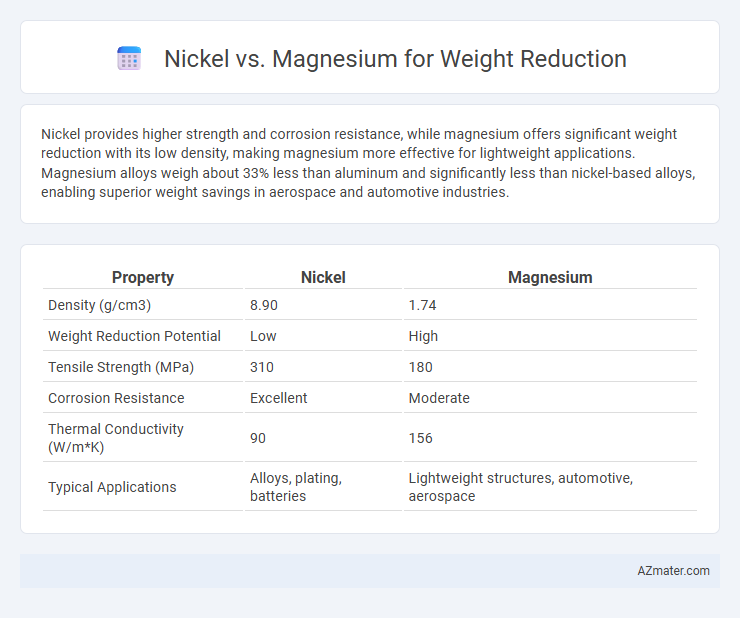Nickel provides higher strength and corrosion resistance, while magnesium offers significant weight reduction with its low density, making magnesium more effective for lightweight applications. Magnesium alloys weigh about 33% less than aluminum and significantly less than nickel-based alloys, enabling superior weight savings in aerospace and automotive industries.
Table of Comparison
| Property | Nickel | Magnesium |
|---|---|---|
| Density (g/cm3) | 8.90 | 1.74 |
| Weight Reduction Potential | Low | High |
| Tensile Strength (MPa) | 310 | 180 |
| Corrosion Resistance | Excellent | Moderate |
| Thermal Conductivity (W/m*K) | 90 | 156 |
| Typical Applications | Alloys, plating, batteries | Lightweight structures, automotive, aerospace |
Introduction: Why Compare Nickel and Magnesium for Weight Reduction?
Nickel and magnesium are critical metals considered for weight reduction due to their unique material properties and applications in lightweight alloys. Magnesium's low density of 1.74 g/cm3 makes it one of the lightest structural metals, ideal for automotive and aerospace components aiming to decrease overall weight and improve fuel efficiency. Nickel, while denser at 8.90 g/cm3, contributes to the strength and corrosion resistance of lightweight alloys, making the comparison essential for optimizing performance and durability in weight-sensitive engineering designs.
Atomic Properties: Nickel vs Magnesium
Magnesium's atomic weight is approximately 24.3 u, significantly lower than nickel's atomic weight of about 58.7 u, making magnesium inherently lighter for applications demanding weight reduction. Magnesium's lower density (1.74 g/cm3) compared to nickel's higher density (8.90 g/cm3) highlights its advantage in minimizing weight while retaining sufficient strength in alloys. The atomic radius of magnesium (160 pm) is larger than nickel's (124 pm), influencing crystal structure and mechanical properties relevant to selecting materials for lightweight design.
Density Differences and Impact on Weight Reduction
Nickel has a density of approximately 8.91 g/cm3, significantly higher than magnesium's density of about 1.74 g/cm3, making magnesium nearly five times lighter than nickel. This substantial density difference allows magnesium to achieve superior weight reduction in applications such as automotive and aerospace components without compromising structural integrity. Consequently, substituting nickel with magnesium dramatically lowers overall system weight, enhancing fuel efficiency and performance.
Mechanical Strength and Structural Suitability
Nickel alloys offer superior mechanical strength and corrosion resistance compared to magnesium, making them ideal for high-stress structural applications despite their higher density. Magnesium is significantly lighter, providing excellent weight reduction benefits but with lower tensile strength and limited structural suitability under heavy loads or impact. Selecting between nickel and magnesium involves balancing the need for durability and load-bearing performance against the critical goal of minimizing weight in engineering designs.
Corrosion Resistance: Longevity in Applications
Nickel offers superior corrosion resistance compared to magnesium, making it ideal for applications requiring long-term durability in harsh environments. While magnesium is significantly lighter, its susceptibility to oxidation and corrosion limits its lifespan without protective coatings. Nickel's ability to withstand chemical and environmental degradation extends the longevity of components in aerospace, automotive, and marine industries.
Cost Efficiency: Nickel vs Magnesium
Magnesium offers superior cost efficiency compared to nickel due to its lower raw material and manufacturing expenses, making it ideal for lightweight structural applications. Nickel, while providing excellent corrosion resistance and strength, generally incurs higher production costs that can limit its use in budget-sensitive weight reduction projects. Choosing magnesium enables significant weight savings with a favorable cost-to-performance ratio in industries such as automotive and aerospace.
Environmental Considerations and Recyclability
Nickel and magnesium differ significantly in environmental impact and recyclability, with magnesium offering superior weight reduction benefits due to its lower density of 1.74 g/cm3 compared to nickel's 8.90 g/cm3, resulting in lighter components and reduced fuel consumption in transportation. Magnesium is highly recyclable with a recycling rate of over 90%, minimizing environmental footprint by reducing the need for primary extraction, whereas nickel recycling involves complex processes due to its alloy compositions, though it remains economically viable with a recycling rate around 67%. The production of magnesium emits fewer greenhouse gases compared to nickel mining and refining, making magnesium a more sustainable choice for industries prioritizing weight reduction alongside environmental responsibility.
Industrial Applications: Aerospace, Automotive, and Beyond
Nickel alloys offer superior strength and corrosion resistance in aerospace components, supporting structural integrity under extreme conditions, while magnesium's exceptional lightweight properties drive weight reduction in automotive parts, enhancing fuel efficiency and performance. Industrial applications favor magnesium for non-critical, lightweight structural elements, whereas nickel is preferred for high-stress environments requiring durability and thermal stability. Emerging technologies explore hybrid materials combining nickel and magnesium to optimize weight reduction without compromising mechanical strength across diverse industries.
Common Alloys and Their Weight Reduction Performance
Nickel and magnesium alloys are widely used for weight reduction in automotive and aerospace industries, with magnesium alloys offering the lowest density at about 1.74 g/cm3 compared to nickel's higher density around 8.9 g/cm3. Common magnesium alloys such as AZ91 and WE43 provide significant weight savings while maintaining adequate strength and corrosion resistance, making them ideal for lightweight structural components. Nickel-based superalloys like Inconel offer superior strength and corrosion resistance but contribute less to weight reduction due to their higher density, typically reserved for high-temperature, high-stress applications rather than primary weight-saving purposes.
Conclusion: Choosing Between Nickel and Magnesium for Lightweight Design
Magnesium offers superior weight reduction due to its low density of 1.74 g/cm3 compared to nickel's 8.90 g/cm3, making magnesium alloys ideal for lightweight applications in automotive and aerospace industries. Nickel provides excellent strength, corrosion resistance, and durability, suitable for high-stress components where weight is less critical. Selecting between nickel and magnesium depends on balancing weight reduction priorities with mechanical and environmental requirements, with magnesium favored for minimal weight and nickel preferred for enhanced structural performance.

Infographic: Nickel vs Magnesium for Weight reduction
 azmater.com
azmater.com